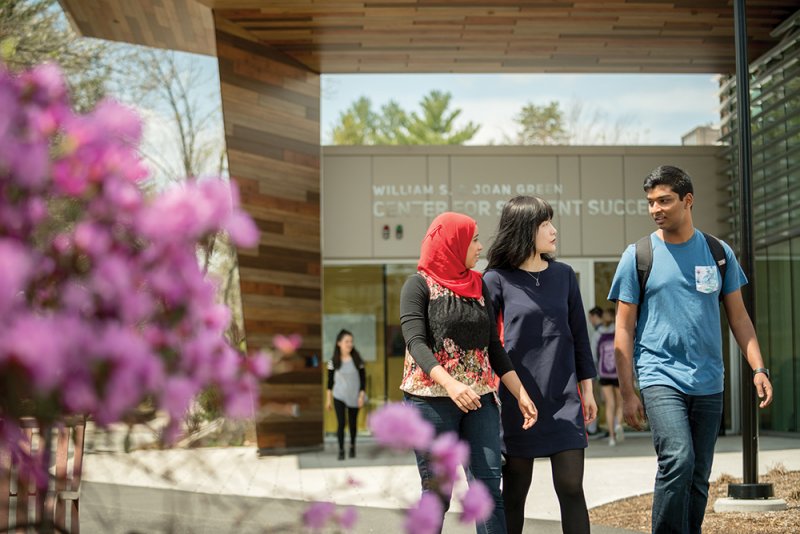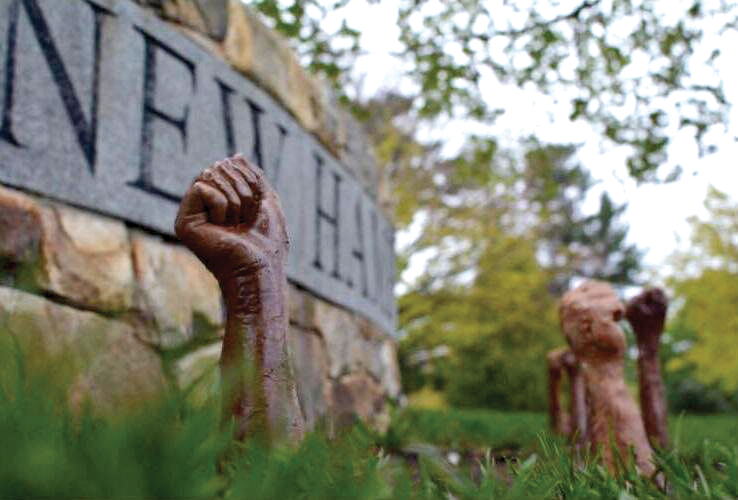
Students at Southern NH University’s Center for Student Success. Courtesy photo.
(Editor’s Note: This series was co-produced by a cohort of five college students from across NH as part of a mentorship project created by The Granite State News Collaborative and its partner, the NH Press Association. Additional reporting and editing was provided by John M. Bassett, Rick Green, Phil Kincade and Melanie Plenda.)
For at least two decades, nationally and in NH, there has been a push to diversify college campuses. Schools have created diversity offices, put resources into recruitment, implemented policies and been vocal about their desire to make higher education a more inclusive place.
While there has been some progress on this front in NH, a review of enrollment data from the five largest, four-year, undergraduate schools—Dartmouth College, Keene State College, Plymouth State University, Southern NH University and the University of NH—shows some have struggled to move their numbers beyond where they were nearly 20 years ago.
For example, white enrollment at University System of NH colleges dipped from about 90% in 2000 to 82% in 2019. This compares to national white college enrollment that dropped from 71% to 55% during the same time period.
The challenge is especially true for increasing Black student enrollment, which rose from about 1% in 2000 to just 1.9% in 2019 at these schools. During the same period, the statewide average of Black students increased from 1.3% to 3.11% at NH degree-granting schools participating in federal aid programs.
The average Hispanic student enrollment at USNH schools generally followed the statewide trend, increasing from less than 1% in 2000 to 3.8% in 2019. The state average for Hispanic enrollment increased from 1.5% to 4.9% during the same period.
The trend holds true for Asian students as well. The share of Asian students at USNH schools increased from 1% in 2000 to 2% in 2019 while the statewide average increased from 1.8% to 3.4%.
According to administrators, this limited success reflects a range of persistent issues that dissuade non-white
students from coming to or even staying in NH. One difficulty in recruiting students of color is an overall state population that is predominantly white. Universities are asking students to leave more multicultural environments to live in communities unaccustomed to interacting with ethnically diverse people.
“My street was all minorities, Hispanics, Blacks,” says Javaughn Taylor, who grew up in the greater Boston area and will be a senior at New England College in the fall. “New Hampshire is strictly white,” he says. “We’d get looks or side looks in the community, or in the store.”
The lack of diversity is evident from the start when students tour campuses. “When families of color visit campus, they do not readily see themselves represented across campus,” say Nadine Petty, chief diversity officer and associate vice president at UNH. “It’s hard to convince potential future students that UNH is for them if they don’t see anyone that shares their identity while they are here.”
“We are in a place in which a lot of students don’t necessarily feel comfortable right?” says Marlin Collingwood, vice president for communications, enrollment, and student life at Plymouth State College. “We’re in the White Mountains of New Hampshire, it’s a very different place both geographically and also, it is not a very diverse place in and of itself.”
Tuition Barriers
Another issue is tuition cost. Students can often pay the same or less to attend schools in more ethnically diverse areas in the U.S. where they feel more comfortable.
Case in point is Jaylin Tully, a Gilford High School graduate who is Black and who plans on attending a four-year university in Florida after graduating from Lakes Region Community College in December.
Her top pick is Florida State University in Tallahassee, where out-of-state tuition and fees of about $20,000 are comparable to that of in-state tuition and fees at the University of NH. “New Hampshire is 94% white, and I’m very obviously not,” says Tully, “I’m hoping to get out and meet more diverse people and get different perspectives on life.”
Attraction/Retention Challenges
Petty points to another challenge. “We have more diverse students applying to UNH than actually choosing to come to UNH,” she says. “We have to do better as an institution to be more attractive to these students and to encourage them to actually come to the institution if they are accepted.”

A solidarity sculpture at UNH. Courtesy photo.
New Hampshire colleges’ quest for increased student diversity is hampered in large part because of the state’s inherent demographics, which limits the pool of in-state students of color.
Demographic changes have been slow in NH. The Granite State’s population went from being 95% white in 2000 to 90% white in 2018. Student enrollments here are similar to other predominantly white states. University of Maine’s total white undergraduate enrollment is 83%; Montana State University’s was 85%; and Boise State University’s was 73%.
Of NH’s five largest institutions of higher learning, Dartmouth College and Southern NH University have made better progress toward diversity, but their circumstances are much different.
On paper, SNHU appears to be among the more diverse schools. As of 2019, white students appear to make up around 57.8% of its students, and Black students make up 15.8%. But a closer look shows this is largely attributed to its online population rather than its on-campus population.
Jada Hebra, senior vice president and chief diversity officer of SNHU’s Office of Diversity and Inclusion (ODI), says SNHU is a different animal when it comes to diversity numbers as the balance in diversity likely comes from the online population since it is cheaper and easily accessible to a wide variety of people. Hebra also says she imagines the on-campus diversity numbers would be similar to other NH schools—below national averages.
Dartmouth College also appears diverse by the numbers in regards to overall variety in race and ethnicity, outpacing national trends of increasing student diversity. In 2018, Dartmouth’s student population was 48.7% white compared to national white enrollment of 55.2%.
But Hispanic and Black students are underrepresented at Dartmouth. Nationally in 2018, Black students made up around 13.4% of total college enrollment. At Dartmouth, Black students only made up 5.1% of its student body as of 2018.
Hispanic students made up about 8.6% of Dartmouth’s population, compared to Hispanics making up 20% of total college enrollment.
A spokesperson for Dartmouth College, Diana Lawrence, says its numbers appear lower because of how the National Center for Education Statistics (NCES), which is a part of the U.S. Department of Education, classifies students. For example, students who might identify as Black but are also of mixed race would be considered in the data under the “two or more races’’ category, and not under Black/African American. Dartmouth students that are multi-racial have hovered around 5% of its student population since 2013.
But classification quirks go both ways for how Dartmouth counts its students and how the NCES collects its data, which means that Black students are still underrepresented on the Hanover campus when compared to national data. Dartmouth did not respond to repeated attempts for further comment.
How to Expand Diversity?
So the question remains, after two decades of trying, what must NH’s largest colleges do to expand student diversity?
Colleges and universities in general need to play a more active role in promoting diversity and inclusion on their campuses, says Dr. Carlos E. Cortés, an independent diversity lecturer and consultant.
“One of the ways [to be more attractive] is by demonstrating and marketing the kinds of things you do to support healthy diversity on your campus,” says Cortés. “Many campuses spout cliches very easily.… They’re not very precise about the ways they [promote diversity].”
In his consultations, Cortés tells colleges and universities to find their “unique ways of supporting diversity” and to market them because, as Cortés puts it, “people get tired of cliches.”
UNH is trying to reach out more to underrepresented students, says Petty. “We need to get the word out to underrepresented students that if they come here, they have opportunities for engagement at various levels,” she says. “I think they already know we are not perfect, but so much of the great things at UNH surrounding diversity and inclusion efforts remain hidden.”
The Black Lives Matter movement also pushed Plymouth State to commit to creating an office of diversity and inclusion.
Originally, the school believed racial and equity issues were already being addressed by existing groups and offices, such as race-based affinity groups.
“But this really made sense right now. We’re going to commit to having an office, and an officer of diversity, equity and social justice,” says Collingwood. “Our hope is that we’re going to find the right person to come and help lead us into the next step.”
But college administration officials still have to show real commitment in fostering an inclusive campus. Cortés says colleges and universities too often hire a diversity officer and stop doing work themselves.
“‘Oh, we got a chief diversity officer. We don’t have to do anything. They’ll take care of everything.’” Cortés says. “It’s important for the commitment for all people on campus or at least all of the leaders on campus to not only be supportive of diversity, but be involved in showing their support in very tangible ways.”
One way for schools to do that is to be more specific in the wake of ongoing issues related to race. “In the face of this horrendous series of anti-Asian acts, do they take positions in which they elaborate on what they are going to do to be supportive? As opposed to just a general thing of ‘Oh we abhor the violence’ and, of course, ‘We don’t want discrimination on our campus,’” continues Cortés.
Kya Roumimper, coordinator of multicultural student support and success and equity education at Keene State College, also makes the point that retaining students of color on campus is greater when colleges and universities invest in the students through student-led peer support groups and leadership programs. “Investment and support ensures people stay and that they persist,” Roumimper says.
She also says that, although this varies in different parts of the country, in New England, it’s in the college age years that students are developing their racial identities. It’s therefore important, she says, to have people teaching and supporting these students who look like these students.
“They may not have the same experiences as these students, but that representation is so important,” she says. “That support is so important.”
New Hampshire’s largest post-secondary institutions are diversifying, albeit slowly. According to Alane Shanks, president of Renga Consulting, which specializes in developing diversity, equity and inclusion strategies, there’s been change, and it might take a while for NH.
“You can’t assume you’re going to have a magic wand and it will change,” she says. “It’s a slow and steady process, and systemic change doesn’t happen overnight.”
These articles are being shared by partners in The Granite State News Collaborative as part of its race and equity project. For more information, visit collaborativenh.org.

 Current Issue - April 2024
Current Issue - April 2024